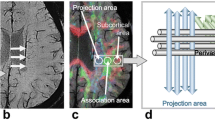Abstract
Time courses of changes in manganese, iron, copper, and zinc concentrations were examined in regions of the brain of a 6-hydroxydopamine (6-OHDA)-induced rat model of Parkinson’s disease using inductively coupled plasma mass spectrometry (ICP-MS). The concentrations were simultaneously determined in brain section at the level of the substantia nigra 1, 3, 7, 10, 14, and 21 days after the 6-OHDA treatment and compared with those of control rats. The distributions of these elements were obtained for 18 regions of the sagittal section (1-mm thick). The ICP-MS results indicated that Mn, Fe, Cu, and Zn levels of the 6-OHDA-induced parkinsonian brain were observed to increase in all regions that lay along the dopaminergic pathway. In the substantia nigra, the increase in Mn level occurred rapidly from 3 to 7 days and preceded those in the other elements, reaching a plateau in the 6-OHDA brain. Iron and Zn levels increased gradually until 7 days and then increased rapidly from 7 to 10 days. The increase in the copper level was slightly delayed. In other regions, such as the globus pallidus, putamen, and amygdala, the levels of Mn, Fe, Cu, and Zn increased with time after 6-OHDA treatment, although the time courses of their changes were region-specific. These findings contribute to our understanding of the roles of Mn and Fe in the induction of neurological symptoms and progressive loss of dopaminergic neurons in the development of Parkinson’s disease. Manganese may hold the key to disturbing cellular Fe homeostasis and accelerating Fe levels, which play the most important role in the development of Parkinson’s disease.



Similar content being viewed by others
References
Woodruff ML, Nonneman AJ (eds) (1994) Toxin-induced models of neurological disorders. Plenum, New York
Ebadi M, Srinivasan SK, Baxi MD (1996) Prog Neurobiol 48:1–19
He Y, Thong PSP, Lee T, Leong SK, Shi CY, Wong PTH, Yuan SY, Watt F (1996) Brain Res 735:149–153
Ponzoni S, Gaziri LCJ, Britto LRG, Barreto WJ, Blum D (2002) Neurosci Lett 328:170–174
He Y, Lee T, Leong SK (1999) Neuroscience 91:579–585
Chung JM, Chang SY, Kim YI, Shin HC (2000) Neurosci Lett 286:183–186
Dexter DT, Carayon A, Javoy AF, Agid Y, Wells FR, Daniel SE, Lee AJ, Jenner P, Marsden CD (1991) Brain 114:1953–1975
Tarohda T, Yamamoto M, Amano R (2004) Anal Bioanal Chem 380:240–246
Dombovari J, Becker JS, Dietze HJ (2000) Fresenius J Anal Chem 367:407–413
Mendez-Alvarez E, soto-Otero R, Hermida-Ameijeras A, Lopez-Real AM, Labandeira-Garcia JL (2001) Biochim Biophys Acta 1586:155–168
Ishida Y, Todaka K, Kuwahara I, Ishizuka Y, Hashiguchi H, Nishimori T, Mitsuyama Y (1998) Brain Res 809:107–114
Ishida Y, Todaka K, Hashiguchi H, Takeda R, Mitsuyama Y, Nishimori T (2002) Brain Res 940:79–85
Paxinos G, Watson C (1998) The rat brain in stereotaxic coordinates, 4th edn. Academic, San Diego, CA
Paxinos G, Franklin KBJ (2000) The mouse brain in stereotaxic coordinates, 2nd edn. Academic, San Diego, CA
Pietra R, Sabbioni E, Brossa F, Gallorini M, Faruffini G, Fumagalli EM (1990) Analyst 115:1025–1028
Jackson BP, Shaw Allen PL, Hopkins WA, Bertsch PM (2002) Anal Bioanal Chem 374:203–211
Arslan Z, Ertas N, Tyson JF, Uden PC, Denoyer ER (2000) Fresen J Anal Chem 366:273–282
Koplik R, Curdova E, Suchanek M (1998) Fresen J Anal Chem 360:449–451
Labandeira-Garcia JL, Rozas G, Lopez-Martin E, Liste I, Guerra JM (1996) Exp Brain Res 108:69–84
He Y, Lee T, Leong SK (2000) Brain Res 858:163–166
Double KL, Gerlach M, Schunemann V, Trautwein AX, Zecca L, Gallorini M, Youdim MBH, Riederer P, Ben-Shachar DB (2003) Biochem Pharmacol 66:489–494
Zheng W, Ren S, Graziano JH (1998) Brain Res 799:334–342
Galazka-Friedmen J, Bauminger ER, Koziorowski D, Friedman A (2004) Biochim Biophys Acta 1688:130–136
Leveugle B, Faucheux BA, Boyras C, Nillesse N, Spik G, Hirsch EC, Agid Y, Hof PR (1996) Acta Neuropathol 91:566–572
Florence TM, Stauber JL (1989) Sci Total Environ 78:233–240
Nagatomo S, Umehara F, Hanada K, Nobuhara Y, Takenaga S, Arimura K, Osame M (1999) J Neurol Sci 162:102–105
Acknowledgements
This work was supported by Grants-in-Aid for Scientific Research (10640539 and 14540512) from the Ministry of Education, Culture, Sports, Science and Technology of Japan.
Author information
Authors and Affiliations
Corresponding author
Rights and permissions
About this article
Cite this article
Tarohda, T., Ishida, Y., Kawai, K. et al. Regional distributions of manganese, iron, copper, and zinc in the brains of 6-hydroxydopamine-induced parkinsonian rats. Anal Bioanal Chem 383, 224–234 (2005). https://doi.org/10.1007/s00216-005-3423-x
Received:
Revised:
Accepted:
Published:
Issue Date:
DOI: https://doi.org/10.1007/s00216-005-3423-x




